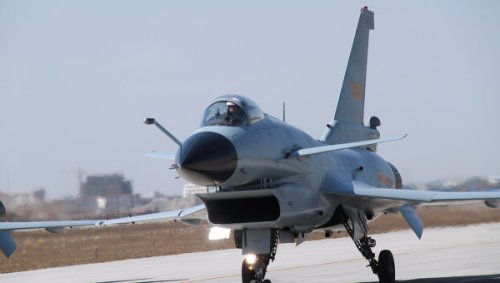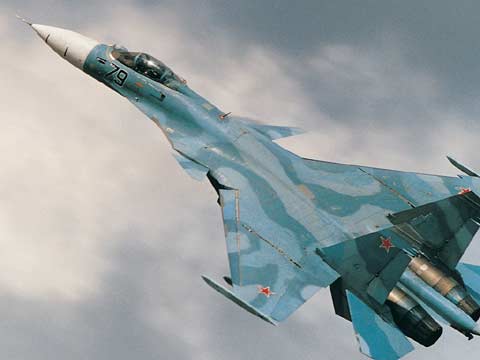Although it’s been a long time since this alleged shark was revealed, it is still worth talking about specifically because of one reason that will be apparent by the end of this article. Photographs of the jet emerged a few months later, confirming a long-held suspicion that China was developing a copy of the Su-33. The first clear view of J-15 (shown above) prototype was leaked in July 2010 revealing a retracted IFR probe behind the port side of the nose and an arresting hook beneath the shortened tailcone. J-15 is the first generation of Chinese shipborne fighter aircraft being developed by both 601 Institute and SAC for PLAN’s first aircraft carrier. According to the aviation sources Beijing unsuccessfully tried to buy Su-33s (shown below) from Russia early this decade. Undeterred, it bought a Su-33 prototype from Ukraine in 2001 and used that to develop its version, designated the Shenyang J-15. Similar to Su-33, J-15 features enlarged folding wings, strengthened landing gears with twin nosewheels, an arresting hook, a pair of small canard foreplanes and a larger wing area to improve its low speed handling and shortened tailcone to avoid tail-strike during high AoA landing. Some key shipborne aircraft technologies such as landing/navigational systems are believed to have been obtained from Russia and Ukraine. One Su-33 prototype (T-10K-3) was acquired from Ukraine around 2001 and has been studied extensively. Many components onboard J-15 are based on those onboard J-11B, such as a similar radar, improved FBW, the same glass cockpit as well as the improved WS-10 turbofan engine. It can also fire a variety of Chinese designed weapons, including PL-8, PL-12 AAMs and YJ-83K AShM. Overall J-15 is believed to be in the same class of American F/A-18C.
China’s factories are infamous for making relatively high-quality reproductions of branded Western consumer goods as well as military. This move was part of China’s plan to build a naval fighter fleet to operate on its forthcoming indigenous aircraft carrier fleet, as China sought to acquire a deep-sea capability. The aircraft is expected first to be stationed onboard the Varyag aircraft carrier currently being fitted in Dalian. China bought the unfinished Admiral Kuznetsov class aircraft carrier from Ukraine in 1998.
Russiam military analysts claim that China’s J-15 carrier-based fighter will not be able to compete with Russia’s Su-33 fighter on global markets because it is inferior to the Russian aircraft:
“The Chinese J-15 clone is unlikely to achieve the same performance characteristics of the Russian Su-33 carrier-based fighter, and I do not rule out the possibility that China could return to negotiations with Russia on the purchase of a substantial batch of Su-33s,” said Col. (Ret.) Igor Korotchenko, a member of the Defense Ministry’s Public Council. According to Russian Defense Ministry sources, the earlier refusal of Su-33 Flanker-D fighters sale to China, was due to findings that China had produced its own copycat version of the Su-27SK fighter jet in violation of intellectual property agreements. In 1995, China secured a $2.5-billion production license from Russia to build 200 Su-27SKs, dubbed J-11A, at the Shenyang Aircraft Corp.
The Sukhoi Su-33 is a carrier-based multi-role fighter aircraft produced by Russian firm Sukhoi beginning in 1982. It is a derivative of the Su-27 ‘Flanker’ and was initially known as the Su-27K. The main differences from the Su-27 are that the Su-33 can operate from aircraft carriers and is capable of aerial refueling. The Su-33 carries guided missiles such as the Kh-25MP, Kh-31 and Kh-41. The plane can be used in both night and day operations at sea. It can operate under assistance of the command center ship, or in conjunction with a Kamov Ka-31 (a variant of the Ka-27) early-warning helicopter. The R-27EM missiles provide it the capability to intercept antiship missiles. Other than air defence, the duties of the Su-33 include destruction of enemy ASW, AWACS, and transport aircraft, anti-shipping strike, support of amphibious landing, escort, reconnaissance, and laying of minefields.
China harbours ambitions aplenty to become a powerful force in aerospace as well as being a rapidly growing marketplace for the global industry’s products and services. China’s air forces are no longer those of a third-world country. The J-15 is credited by the Chinese as indigenous development, but the Russians consider it a rip-off of a Sukhoi Su-33. I would however go with the former, the differences will be apparent in my next post. One thing however, I would point out here is, J-15 project is one of chinease dream projects, other includes J-11A/SU-27, J-11B, J-10A/J-10B and JH-7A/B









Stealing and copying can only get you so far ….. !!
And it is likely that the thief will never get to see the real stuff……!
Military technology wise, China will never be close to the best…… therefore average quality with numerical superiority will be the foundation of their strategic doctrine.
well even copying is an “art”, and we all are artists, i didnt say that, picasso did
Pingback: Russia Sells; China Clones | Red Storm Rising
The picture shown above is a Chengdu J-10A…not a J-15
Btw europe copied chinese tech in the 1400s. Thief?